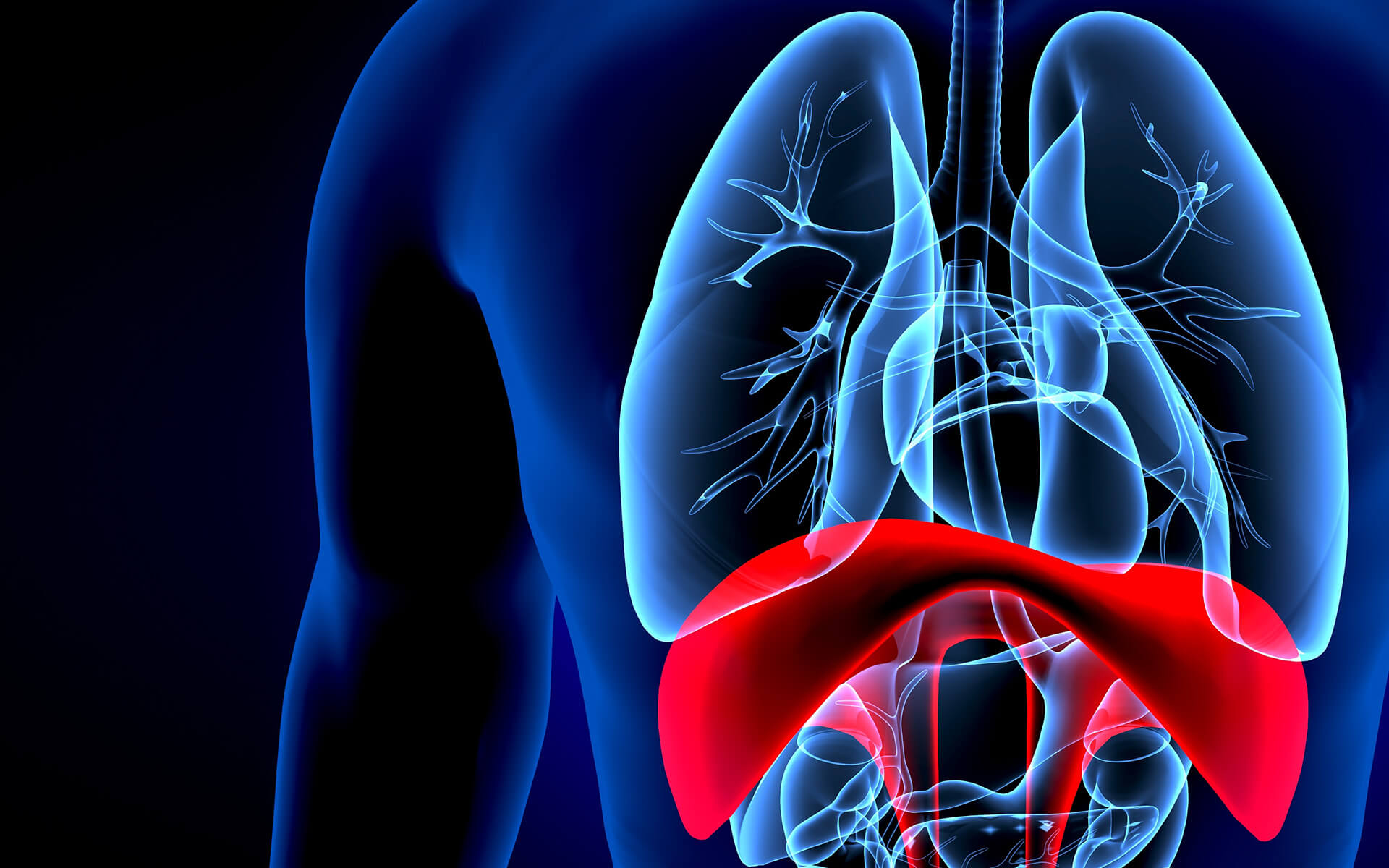The diaphragm is a muscle inside your chest cavity that plays a critical role in your lung function. As the muscle contracts, air fills your lungs. When it relaxes, the diaphragm expands and forces air out of your lungs. Sometimes, the diaphragm muscle can become weakened or paralyzed, leading to a condition known as diaphragmatic paralysis (DP).
The most common cause of diaphragmatic paralysis is direct trauma or trauma resulting from a surgical procedure. A weakened or paralyzed diaphragm can affect anyone from newborns and infants to aging adults. Diaphragmatic paralysis can be unilateral (affecting either the left or right side of the muscle) or bilateral, affecting the entire diaphragm on both sides. Regardless, a paralyzed or weakened diaphragm can lead to reduced lung function.
For infants, paralysis of the diaphragm may lead to life-threatening respiratory distress. In this case, waiting for the issue to self-resolve may prove to be fatal. If your infant is struggling to breathe, please seek medical assistance immediately.

Understanding Diaphragm Paralysis

What is Diaphragm Paralysis?
Symptoms
In many cases, diaphragm paralysis presents with no symptoms at all. For others, dyspnea (shortness of breath) is the primary symptom. Up to one-third of patients will experience exertional dyspnea: shortness of breath when exercising.
Difficulty breathing at rest or exertion is the most common symptom of diaphragmatic paralysis. However, patients with a paralyzed or weakened diaphragm may also experience disturbed sleep, sleep-disordered breathing, and daytime fatigue.
Symptoms of diaphragmatic paralysis can include:
- Difficulty breathing, both at rest and when active
- Difficulty sleeping
- Fatigue
- Recurrent pneumonia
Causes
The diaphragm is connected to your nervous system via the phrenic nerve. When phrenic nerve damage occurs due to pinching, injury, or compression (by cervical spondylosis, a tumor, or cancer), paralysis of the diaphragm may occur. Up to 20% of paralyzed diaphragms are idiopathic, meaning the cause is unknown. However, the vast majority of cases can be attributed to:
- Neuromuscular disorders, including amyotrophic lateral sclerosis (ALS), multiple sclerosis, and muscular dystrophy.
- Spinal cord disorders and quadriplegia.
- Bypass surgery (up to 20% of cardiac bypass surgeries result in temporary diaphragm weakness).
- Birth trauma (the main cause of paralyzed diaphragms in infants).
Risk Factor
Tests and Diagnosis
A medical professional will diagnose diaphragmatic paralysis based on a combination of the patient’s medical and family history, physical exam, and additional testing (if needed), including:
- Chest Radiographs: chest X-rays can diagnose up to 90% of diaphragm paralysis
- Fluoroscopic Evaluation: similar to an X-ray, this test looks at a moving image of the chest
- Pulmonary Function Tests: non-invasive tests that measure lung function (volume, capacity, air flow)
- Electromyography (EMG): measures muscle and nerve response
- Transdiaphragmatic Pressure Measurements: a measurement of respiratory muscle function
- Thorax Ultrasound: ultrasound of the thorax region (upper trunk between neck and diaphragm)
- CT Scan: uses X-ray and computers to display an image with more detail than a standard X-ray
- MRI: magnetic resonance imaging uses magnetic fields and radio waves to create an image
- Sleep Study: monitors continuous positive airway pressure (CPAP) or bilevel positive airway pressure (BiPAP)
- Laboratory Tests: to assess underlying conditions that may be the cause of diaphragm paralysis, such as thyroid issues or Lyme disease. Other tests, such as a complete blood count, may rule out anemia as a potential cause for dyspnea.
Treatment Options for Diaphragm Paralysis
It is not uncommon for a patient with diaphragm paralysis to be asymptomatic (have no symptoms). In this case, where the condition was likely discovered incidentally, no intervention is required. In other cases, a “wait and watch” approach may be appropriate if the condition is not impacting quality of life.
For mildly symptomatic patients or symptoms that worsen at night, CPAP or BiPAP may help. If the condition is acute and can be corrected, we specialize in the following treatment options for diaphragm paralysis:
Correct the Underlying Issue
Many cases of paralysis of the diaphragm result from an underlying cause that can be corrected, such as a viral or bacterial infection or diabetes. If the condition is caused by the compression of the phrenic nerve, for example, surgical nerve decompression may be the best option to improve respiratory function.
Ventilatory Support
Non-invasive positive pressure ventilation or invasive ventilation can be used for patients that develop a lung pathology to help the patient return to baseline status. For invasive ventilation, recovery time can equate to one week recovery for every day on a ventilator.
Surgical Plication
This minimally invasive surgical option sutures the diaphragm into a stable position. Many studies have shown that surgical plication helps to improve vital capacity, exercise tolerance, dyspnea, and pulmonary function. Recovery time can take about 8 to 12 months, and it’s not uncommon to feel tired for up to eight weeks post-surgery.
Phrenic Nerve Pacing
This treatment option uses a pacemaker to stimulate the phrenic nerve, causing the diaphragm muscle to contract. One study of phrenic nerve pacing demonstrated improvement in 81 percent of patients. Recovery time after a phrenic nerve pacing procedure takes approximately 6 weeks.
Phrenic Nerve Surgery
In some cases, phrenic nerve surgery may be required to reverse diaphragm paralysis. Reconstructive surgical decompression or transplants allow surgeons to restore the connection between the phrenic nerve and diaphragm muscle.
Our Doctors
Patient Stories


Insurance Information
The Institute for Advanced Reconstruction participates in a wide range of insurance plans, including those listed below. However, each physician has their own accepted insurance and hospital affiliations. Before scheduling an appointment, please contact your insurance carrier to confirm that your provider is in-network.
If we are not an in-network provider, our friendly insurance specialists will help you find the most coverage available for your treatment.
- Horizon Blue Cross Blue Shield of New Jersey
- Medicare
- Railroad Medicare
- Aetna
- Cigna
- United Healthcare
- Oxford (Freedom, Liberty)
- MagnaCare
Patient Resources
Visit our resource page for patient forms, information specific to diaphragm paralysis, and more.
Are you a candidate for diaphragm paralysis treatment?
While many cases of paralyzed diaphragm self-resolve, treatment may be required if your symptoms have lasted for longer than six months, or if they are impacting your ability to sleep and function. If you are experiencing dyspnea (shortness of breath) during typical activities, such as exercising or resting, contact the Institute for Advanced Reconstruction and schedule a consultation to find out if you qualify for diaphragm paralysis treatment today.




-1.jpg)
-1.jpg?width=110)


-1.jpg?width=111)


-1.jpg?width=123)

